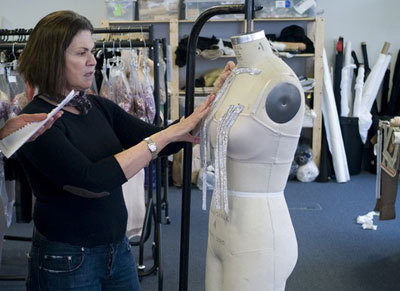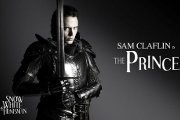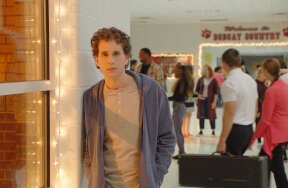By Lynn Barker
Wanna grow up to design costumes for movies? Wonder how it’s done? Check this out! Last Fall Kidzworld was sent to England by Universal Studios to visit the sets of Snow White and the Huntsman. In addition to watching Kristen, Chris and the prince Sam Claflin in costume shooting their scenes, we were given an awesome tour of Oscar-winning costume designer Colleen Atwood’s workshops for the film and saw the costumes then in various stages of completion.

It’s especially cool now to see the finished products on display while we chat with Colleen in Los Angeles. Johnny Depp just told us “Colleen Atwood, with her amazing eye and incredible taste, has a real magic. As soon as you don that armor that she’s created, the character starts to come alive so it’s almost like working from the outside in, in a sense”. Wow, now that’s a compliment and we see why. This is one talented (and friendly) lady.
Kidzworld: I haven’t seen you since we were at Pinewood Studios last October on a set visit for Snow White and the Huntsman. Then, you were still making a lot of these gorgeous costumes that now surround us.

Colleen: Exactly. I remember you from that tour.
Kidzworld: Thanks! We wanted to update everyone now that everything we saw in the making in England is finished and shot. We’re surrounded by things we saw only half made then and they are gorgeous! Kids and teens might want to know what kind of training and talent does a person need to become a costume designer, especially for films?
Colleen: I think there are all kinds of ways to define talent and there are certain personality types that suit costume design more than others. There are all kinds of costume design and ways of approaching it. I think that having an overall background in all kinds of studies helps rather than just studying about clothes.
Basically, you are designing characters; people on the street, fantasy people but if you can connect it with experiences that you’ve had, people you’ve known in your life or places you’ve seen, I think it makes you a better designer. It’s not just going to the right school and having all the right credits.
.jpg)
Kidzworld: How did you, personally, come to the world of costume design?
Colleen: I came into costume design a totally different way than other people did. I always wanted to be an artist. I had a very artistic bent; studied painting and art, then went into fashion and came into costume design that way. Everything I did when I was younger, tied into my life later which is typical with any career. They end up connecting in some way later in your life. I think it’s made my life and work more interesting.
Kidzworld: So kids and teens should just be observant and use their own experiences in their art. Very cool! Can you tell us a bit about the process of designing clothes for a film….or your process anyway?
- Colleen: For costume design generally, the first thing I get is a phone call and the script. To have a conversation (with the director) about the characters without knowing the story doesn’t matter. So far I’ve been lucky enough to work on movies where there are scripts Sometimes people get jobs where someone says “Well, it’s this action thing and there is this guy and that guy and they blow up that”. I usually work with directors that have a screenplay almost in place by the time they call me in. Then you have your ideas and talk to them.
.jpg)
You get the director’s vision of what the film is, then take that idea and go and start a research and development process. You often don’t have a month to research and a month to do sketches. You are doing all of it at once; a budget, design work and your concept work all at the same time. The costume supervisor works with you and you sort of do the budget together. They can tell you when you are over budget and you can pull back.
I’ll begin with a sketch artist, a research person and my costume supervisor and an office assistant. We’re on for two or three weeks together and we get a presentation together for the director. Then we have a second meeting with concept and costume ideas and fabric swatches that I’ve gone out and gathered. That’s part of my inspiration.
Kidzworld: How did you do things especially for Snow White and the Huntsman?
- Colleen: For “Snow White” we had public library research from art books, and museum collections and online research. That’s the initial two to three weeks. This movie exploded to different things. We had the dwarves so we started going scale tests. You take a drawing and blow it up to life-sized with the shape of an average human body, then take a little person and blow their drawing up to life-sized to give it all the proportions. We did use little people with make-up that matched the actors for a lot of middle ground stuff to cheat for the visual effects. So, that’s a side thing going on.
.jpg)
Then we had the armies; this army (she indicates the armor in the room) and the silver army from the movie’s trailer. We manufactured those. That process is a six month process from start to finish when you are assembling five or six hundred armor costumes. You not only have to figure out the armor but what is under the armor. We went from drawings to maquettes (three dimensional “dolls”).
Basically the real design is not on a flat piece of paper but when you put it on a form and start doing it in three dimensions. I’m very involved in the draping and cutting of the costumes. For armor, you go to a full life-sized sculpt of the armor. We came up with reptile scales for Ravenna’s army. Each scale palette is clamped on with a jewelry ring and one skirt probably took one person three days. You can’t do that on three hundred costumes, just a few.
I develop the action costumes with a stunt person in them as my fit model because then I know how it functions. I know they can squat in it, they can lift it over their heads. As we go into the movie with the expectations the director has for the action, I can design a costume that works for action but still looks like a period piece. It’s very technical.
Kidzworld: So the costume has to also be functional so the actor can move etc.?
- Colleen: You also have to think of how long it takes a costume to go on and off at the end of the day. You have to make it so the actor can go to the bathroom. Everybody’s gotta do that, right? (laughs). Also at least the under layer is washable. More than one person would wear some costumes. The funk factor is huge when you work in armor all day long. You are gonna sweat doing action and in the dirt.

Kidzworld: Do you get to travel a lot looking for swatches and fabrics?
- Colleen: One of the parts of my job is travelling but you can’t just say “Oh, I wanna go to Italy shopping”. It’s not that glamorous. On this movie I needed a lot of extras’ costumes. Different costume houses have different strengths and weaknesses. You have to rent some costumes. I was based in Europe and prepped the movie in the U.K. so I could go to Italy for a day and come back.
.jpg)
I also went to a costume house in Spain and when I’m there I see what is there. I got the idea for Johnny Depp’s hat in Alice in Wonderland from a place in Italy. You go to all these places and I went to a fabric store in Paris for Ravenna’s wedding dress. I have a group of places I like to go. Turkey is a fantastic source for material for certain things. You have to calculate the cost of shipping this stuff into your budget.
Kidzworld: Do you sketch stuff or take a picture when you see it, thinking you might use it later in another movie?
- Colleen: I don’t take out my phone that often and snap pictures. I just remember it. Sometimes I remember things as they are in my imagination so I don’t want the literal picture in front of me. That makes it more individual.
.jpg)
Kidzworld: These costumes are so intricate and detailed. How to you know when to stop?
- Colleen: It depends on what the costume has to do and how may I have to make. If I know I have to have 10 of a costume it can’t take a zillion man hours to make. If the material is limited it’s okay if you only need one of it. Vendors don’t carry the stock they used to carry so the purpose and the action for the costume determines how far (in detail) I go with it. Sometimes I have storyboards that show how much you will see. If I know you won’t see much of the costume from the waist down, I put the “bang” up top.

































